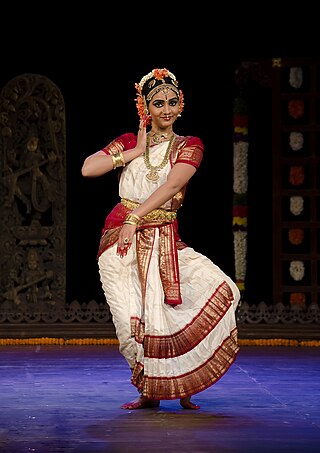
Bharatanatyam is an Indian classical dance form that originated in India. It is a classical dance form recognized by the Sangeet Natak Akademi, and expresses South Indian religious themes and spiritual ideas, of Hinduism and Jainism.

Venkateshwara or Venkatachalapathi is a form of the Hindu god Vishnu and is the presiding deity of the Venkateshwara Temple, located in Tirupati, Andhra Pradesh, India. Venkateshwara is also known by various other names.

Kuchipudi is one of the eight major Indian classical dances. It originates from a village named Kuchipudi in the Indian state of Andhra Pradesh. Kuchipudi is a dance-drama performance, with its roots in the ancient Hindu Sanskrit text of Natya Shastra. It developed as a religious art linked to traveling bards, temples and spiritual beliefs, like all major classical dances of India.

Dance in India comprises numerous styles of dances, generally classified as classical or folk. As with other aspects of Indian culture, different forms of dances originated in different parts of India, developed according to the local traditions and also imbibed elements from other parts of the country.

The Jangam or Jangamaru are a Shaiva order of religious monks. They are the priests (Gurus) of the Hindu Shaiva sect, Gurus of Veerashaiva sect and are disciples of Shiva as mentioned in Basava Puranas. The meaning of word Jangam is 'moving linga'. Jangama is one who is endowed with true spirit of Agamic knowledge, and has sacrificed his life for giving Samskara (good) character building practices in all sections of the Hindu society.
The dance forms of Andhra Pradesh take on a wide variety of colors, costumes, and types; and involve different settings and musical instruments.

Thirunallar is a small town in Karaikal, India, in the Union Territory of Puducherry, and can be reached by road from the town of Karaikal, an enclave which lies within the neighbouring state of Tamil Nadu. Thirunallar contains the shrine of Lord Sani (Saturn), Tirunallar Saniswaran Temple within the temple dedicated to Lord Darbharanyeswaran, a form of Lord Shiva.
The Sanjay Education Society's College of Engineering and Polytechnic was founded in 1983. The college is affiliated to the North Maharashtra University, Jalgaon, India, under purview of the AICTE. The surrounding area is mostly arid with some farmland.

Karnataka has a variety of traditional arts, including folk dance and puppetry.

Veeragase/Guggla is a dance form prevalent in the state of Karnataka, India. It is a vigorous dance based on Hindu mythology and involves very intense energy-sapping dance movements performed by Jangama. Veeragase is one of the dances demonstrated in the Dasara procession held in Mysore. This dance is performed during festivals and mainly in the Hindu months of Shravana and Karthika. It is performed at all important functions of Veerashaiva Lingayat household the veeragase artist's are called as puravanta in village side.

Raghunath Manet is a French classical musician/music composer and dancer/choreographer, writer, film maker and actor, born in the Union Territory of Puducherry. He is trained in Bharathanatyam and plays the Veena, a Carnatic instrument. He has collaborated with Gilberto Gil, Aldo Brizzi, American Jazz musician Archie Shepp, American dancer Carolyn Carlson, French performers such as Richard Galliano, Didier Lockwood and Michel Portal and Indian musician Dr Balamurali Krishna and Drums Sivamani.

The culture of Andhra Pradesh embodies some very exclusive and special entities.

Mylara Lingeshwara Temple is a Hindu temple dedicated to the god, a form of the god Shiva in Mylara. Located at center of Karnataka, It is in the extreme south-western corner of Hoovina Hadagali taluk, Vijayanagara district, Karnataka, India. It is 2 km from Tungabhadra river and 36 km from Hadagali 36 km from Ranebennur and 39 km from Harapanahalli
Patloni is an Indian village about 5 kilometres (3.1 mi) from Baldeo on the road joining to Agra. The foundation of Patlauni village was laid something in 1625
Nomula is a village and a Gram panchayat of Nalgonda mandal, Nalgonda district, in Telangana state.

The taal, manjira, jalra, karatala, kartal or gini is a pair of clash cymbals, originating in the Indian subcontinent, which make high-pitched percussion sounds. In its simplest form, it consists of a pair of small hand cymbals. The word taal comes from the Sanskrit word Tālà, which literally means a clap. It is a part of Indian music and culture, used in various traditional customs e.g. Bihu music, Harinaam etc. It is a type of Ghana vadya.

Pallikondeswara Temple(also Pradosha kshetram) is a Hindu temple dedicated to the god Shiva located in Surutupalle, a village in Tirupati district of Andhra Pradesh, India. The presiding deity Pallikondeswara, unlike other Shiva temples, is sported in reclining posture lying on the lap of his consort Parvati.
Veerabhadra Temple is located on Devakuta Parvatham, a hillock on an islet amidst the Godavari River near Pattiseema in West Godavari, Andhra Pradesh. The temple is dedicated to Shiva and the namesake is Veerabhadra.

Natyam is a 2021 Indian Telugu-language dance romantic drama film written, directed, filmed and edited by Revanth Korukonda. The film is produced by Sandhya Raju who also plays the main lead role.













